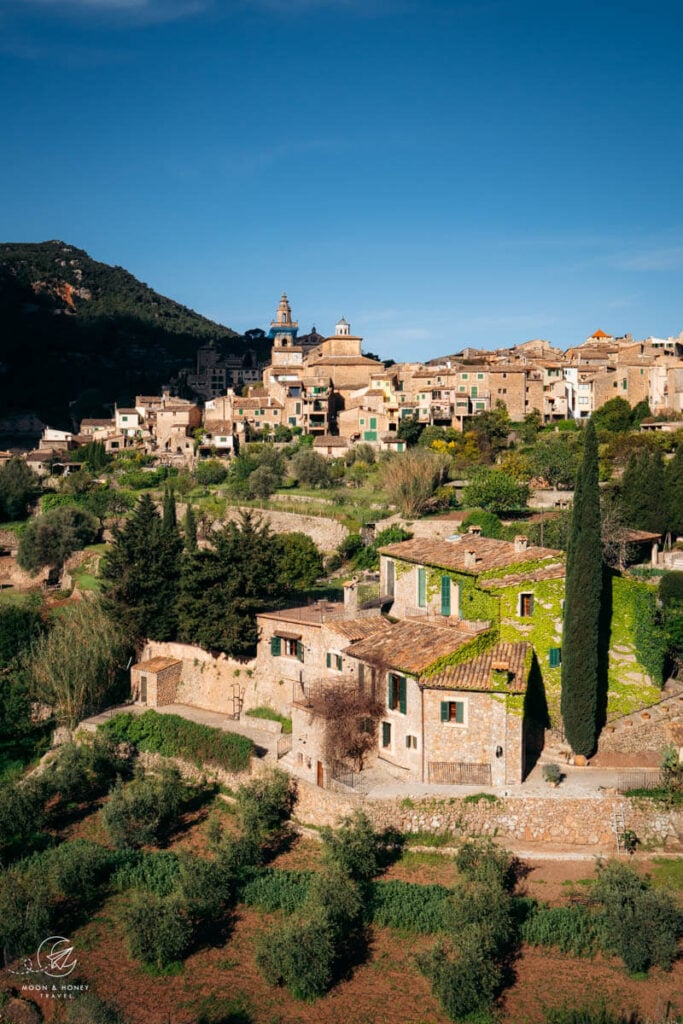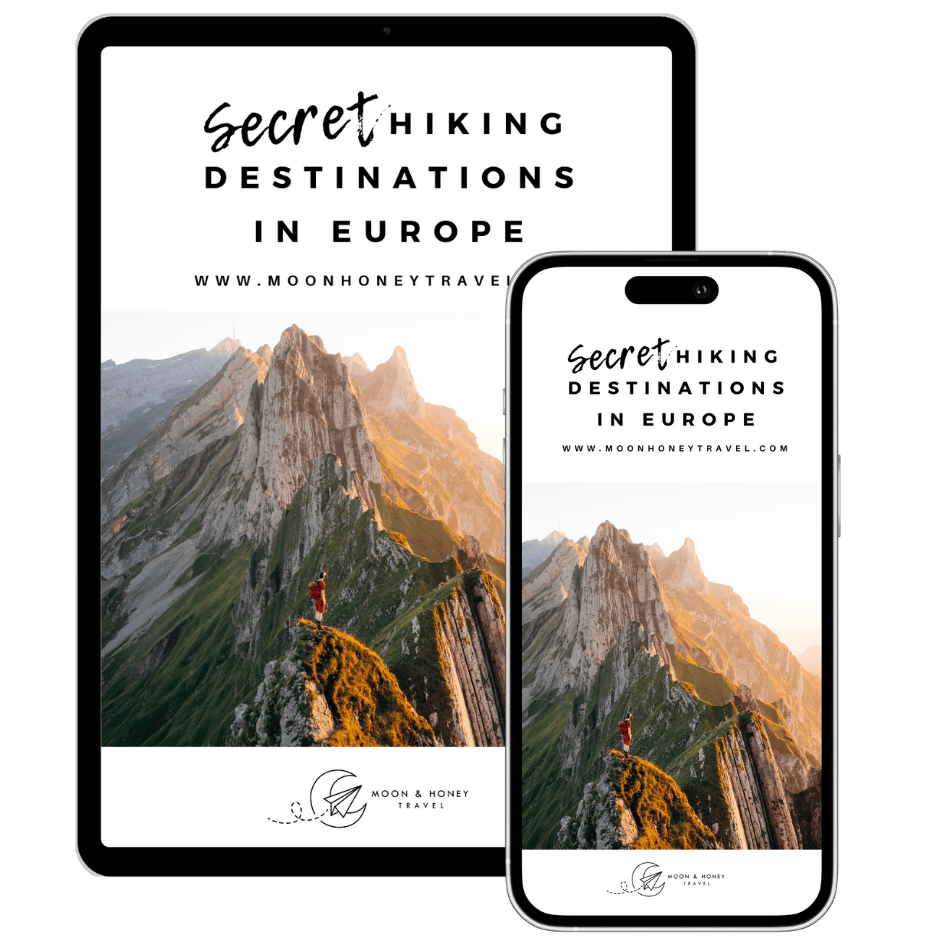As days get longer and temperatures warm, Europeans wake up from their winter slumber, pour out into public spaces, and dine al fresco. There is a general uplift in mood and disposition, and dare I say it, Europeans start to smile again.
Though spring comes early to Southern Europe (March), the season of rebirth doesn’t quite arrive in Northern Europe until much later.
When traveling to Europe in April and May, prioritize Southern Europe and Mediterranean destinations.
The spring season in many Alpine and Nordic European destinations is a fleeting few days between the “winter” and “summer” seasons. Don’t expect blooming wildflowers in the Alps until June.
There are exceptions of course, which we’ll discuss below.
Each year, readers ask us for spring hiking recommendations. In an effort to answer these common questions and clean up our inbox, we’ve compiled all our recommendations in this Europe spring destination guide.

- Spring Season: The spring season commences in March, April, or even May, depending on the destination.
- Top European Cities To Visit in Spring: Marseille, Porto, Vienna, and Amsterdam
- Top Spring Hiking Destinations: Calanques National Park in France, Kotor in Montenegro, Mallorca in Spain, Portugal, and Cornwall in England
- Car Rental: We recommend using the Discovercars.com car rental platform to search for and book car rentals. This easy-to-use booking platform compares car rental deals from 500+ trusted providers, so that you can choose the best option for your trip.
- Accommodation Booking: We book all our hotels and accommodations using the user-friendly and time-saving booking.com platform, because of their cancellation options and transparency (no hidden fees).
1. Calanques National Park, Southern France

Calanques National Park, a magnificent expanse stretching between Marseille and La Ciotat along the Mediterranean coast of Southern France, holds the distinction of being the first national park in Europe to encompass land, sea, peri-urban areas, and islands.
This dramatic coastal region of Provence is renowned for its soaring limestone sea cliffs, deep and narrow calanques (inlets), and distinctive flora and fauna.
There are 26 calanques in the park, most of which are only accessible by foot, or by boat.
Cassis and Marseille, France’s second-largest city, serve as the primary gateways to Calanques National Park.
In May, Kati and I traveled to Provence, where we spent a week exploring the park and the vibrant city of Marseille.
We tackled the coastal trail linking Cassis with Marseille through a series of invigorating day hikes. For a detailed account of our adventure, refer to our Marseille Calanques itinerary.
We were captivated not only by the breathtaking beauty of the Calanques but also by the exhilarating ruggedness of the cliffside trails.
For an optimal visit to Calanques National Park, plan your trip in the spring (March – May) or autumn (October – November). It’s far too hot to hike here in summer. And, the park is often closed between June and September due to fire risk.
Learn More: Hiking in Calanques National Park
2. Bay of Kotor, Montenegro

Set between dramatic limestone massifs of the Dinaric Alps, the Bay of Kotor is one of the most impressive destinations along the Adriatic Sea.
The Bay of Kotor, the diamond of Montenegro, is defined by plunging cliffs and Venetian-style seaside villages. It’s a scenic and historic wonder.
The most famous attraction in Bay of Kotor is the well-preserved medieval town of Kotor, a UNESCO World Heritage Site. Another must-see attraction is the seaside village of Perast.
Kotor is an ideal spring getaway destination, because the weather is mild, it’s not overly crowded, and there are many day trip opportunities.
We stayed a week in Kotor in early May. In addition to exploring the UNESCO-listed Old Town, we tackled various hiking trails including Ladder of Kotor, the Kotor Fortress, Vrmac, and Pestingrat. We also took day trips to the Budva Riviera, Lovcen National Park, and other villages around Boka Bay.
When booking your accommodation in Kotor, it’s imperative to understand the geography of the Bay. Discover your perfect base, tailored to your unique travel preferences, in Where to Stay in Kotor.
Learn More: Best Things to Do in Kotor
3. Soca Valley, Slovenia

Generally speaking, there are two main seasons in the European Alps: winter (December – March, or early April) and summer (June – mid September). Autumn (October) is a very promising time to visit so long as the weather holds and there aren’t massive snow storms coupled with low temperatures.
So what about spring in the Alps? In most areas, spring is a “dead tourist season.” Hotels, restaurants, and tourist infrastructure shut down for several weeks. There is usually too much snow for hiking and not enough snow for skiing.
Those that are keen to explore the Alps in spring should choose their destinations wisely.
The Slovenian Alps is a great option for late spring, if you stick to lower-elevation, sub-alpine trails. This is not the right time to summit Mount Triglav or traverse the Julian Alps, as these trails are carpeted in snow and the high-elevation mountain huts are still closed.
However, it’s a perfectly adequate time to trek the multi-day Juliana Trail and the Slovenian-stages of the Alpe-Adria long-distance trail.
For the best experience, we recommend booking one of these self-guided hiking tours with Slotrips, a trustworthy tour operator run by locals who know every corner of Slovenia.
- 4-Day Alpe Adria Trail Adventure (May – October)
- 8-Day Best of Alpe-Adria and Juliana Trail (May – October)
- 9-Day Mountains to Sea (May – October)
For a guided experience, check out the popular small group 8-day Best Walks in Slovenia hiking tour, bookable as early as April.
4. Mallorca, Spain

The Spanish Balearic Island of Mallorca in the Mediterranean Sea is another spectacular destination for spring travel and hiking.
Mallorca may be famous for its beaches and party scene, but it’s also a stunning island to explore on foot. The best hiking trails in Mallorca are concentrated in the Tramuntana mountains, an impressive limestone range which forms the northwestern backbone of the island.
You can follow this 7-day Mallorca road trip itinerary to experience the most scenic landscapes, mountain villages like Valldemossa, and hikes across this beloved Spanish island.
If you’re interested in a 8-10 day multi-day hike, take a look at the GR221 (aka The Dry Stone Route). This 140-km trail follows old stone pathways and mule tracks from village to village across the Serra de Tramuntana. For more info, check out the GR221 map in our April in Mallorca guide.
5. Portugal

Spring is the season to visit Portugal, as it’s neither too hot, nor too crowded. Daytime temperatures are conducive to coastal hiking and active exploration.
If you’re traveling without a car, consider following our 2 Week Portugal Itinerary which links Porto, Lisbon, and the Sintra Coast, with the Vicentine Coast and Algarve. This Portugal travel itinerary is very unique, because it includes the 4-day coastal Fisherman’s Trail.
This Portuguese Trek is part of the Rota Vicentina trail network. It’s widely considered one of the most stunning coastal hiking trails in Europe, because of the pristine, rugged landscapes and charming coastal villages along the way.
The original Fisherman’s Trail was 4-days long, starting in Porto Covo in Alentejo and ending in Odeceixe in Algarve. Along the way, hikers stay in guesthouses, or hostels in the villages of Vila Nova de Milfontes, Almograve, and Zambujeira do Mar.
In recent years, the trail has been expanded all the way to Lagos in Algarve.
Whether you hike the original 4-day trek, or the extended 13-day trek, hiking the Fisherman’s Trail is an unforgettable experience.
Luggage transfer is available, which makes this trek even more attractive, especially if you’re planning a longer trip to Portugal and/or Europe.
Those looking for sun-kissed beaches, flanked by golden limestone cliffs, can spend their whole time exploring Algarve, the southernmost region of Portugal. Read our Algarve Road Trip Itinerary and Where to Stay in Algarve to start planning your Portugal spring holiday.
6. Cornwall, England

Cornwall (Kernow) is a county in southwest England as well as a recognized Celtic nation with a strong local (Cornish) identity, language, and flag.
For the English, Cornwall is a favorite summer holiday destination. For North Americans, Cornwall is the land of Poldark and Doc Martin. And for us, Cornwall is a bewitching coastal paradise that represents the life we truly want.
The Cornish coast is defined by vast sweeps of golden sand backed by sea cliffs, across which coastal paths meander and sheep graze. Tucked away in smuggler’s coves, you’ll find the dreamiest villages, filled with B&Bs, historic inns, and pasty shops.
Though I have no scientific proof, I believe Cornwall is home to some of the happiest people and happiest dogs in the world. If I reincarnate as a dog, it better be in Cornwall.
A few years ago, we spent the entire month of May in Cornwall, specifically in Newquay. Though the weather wasn’t perfect every day, our trip was perfect. We ate our weight in Cornish pasties and cream tea. We visited numerous Cornish beaches and villages. And we spent hours and hours walking along the South West Coast Path.
If you need a retreat defined by peace, walking, and pristine beauty, go to Cornwall in May. Cornwall will restore you.
Learn More: 3-Day Cornwall Road Trip Itinerary
More Europe Travel Guides
Spring Travel:
Seasonal Guides:
Europe Travel Inspiration:
Hiking in Europe:
- Best Treks in Europe: Multi-Day Hiking Adventures
- Best Day Hikes in Europe
- Tips for Hiking in the Alps
- Best Hikes in the Alps

Pin this Image for Future Trip Planning!
Stay Connected:
Connect with us on Pinterest.
Follow us on Instagram.
Like us on Facebook.
Support Us:
If you love reading our content, you can buy us a coffee via Ko-Fi.



